* (restored/expanded)
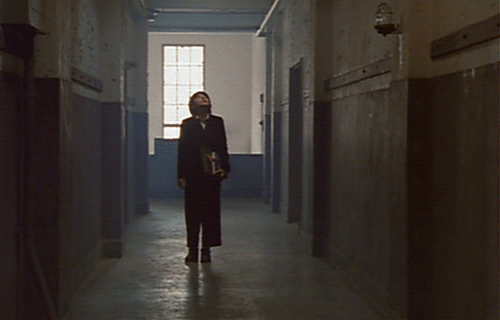
‘Death looms over the films of Hirokazu Kore-eda. His first fiction feature, Maborosi (1995), is a quiet study of bereavement, about a young woman struggling to move on after her husband’s inexplicable suicide. In After Life (1998), a supernatural fable about the materiality of memory (and of film), the newly deceased find themselves in an ethereal limbo where they pick a single worldly recollection to be turned into an eternal celluloid keepsake. Distance (2001) observes the conflicting emotions—the sorrow, shame, and incomprehension—of the relatives of cult members who participated in a fatal terrorist attack and a ritualistic mass suicide.
‘Both the novelistic touches and the documentary details in Kore-eda’s work reflect his formative years—he studied literature at Tokyo’s Waseda University and began his career making nonfiction films for Japanese television. The themes of loss and memory, not to mention his signature empathy for traumatized figures, are present in most of his early documentaries. However . . . (1991) links the life stories of two suicides: a bureaucrat in charge of Japan’s social welfare system and a woman who was a casualty of its failures. August Without Him (1994) centers on the first Japanese man to publicly admit contracting HIV through gay sexual contact; Without Memory (1996), likewise structured around direct encounters with the subject, is about a man who, due to a botched surgical procedure, suffers from a rare form of amnesia that prevents his brain from creating new memories.
‘Many of Kore-eda’s documentaries have informed his fiction films. He adapted Maborosi from a novel but, in shaping his heroine, also drew from the government official’s widow in However . . . . The fascination with mnemonic process in After Life stems from the stranger-than-fiction case of Without Memory. Beyond his own nonfiction work, Kore-eda has also borrowed from real-life events. The cult in Distance is modeled on the notorious Aum Shinrikyo group, which launched sarin gas attacks on the Tokyo subway in 1995. Nobody Knows—which has affinities with Kore-eda’s first documentary, Lessons from a Calf (1991), about elementary school kids learning to care for a calf (and in the process to cope with loss)—is loosely based on a child-abandonment news story that scandalized Japan in the eighties.
‘Still Walking, Kore-eda’s most personal work, has strong elements of autobiography. He has said that he made it in response to the death of his mother, whom he nursed toward the end of her life, and the film is full of personalizing details, the sense memories of childhood. It lingers in the kitchen as daikons are peeled, carrots chopped, edamame washed and salted. The humble corn tempura fritter is the equivalent here of Proust’s madeleine, and Kore-eda captures the vivid details of its preparation, from the snapping of the kernels off the cob to the crackle of the batter as it hits the hot oil. The film’s title comes from the lyrics of a 1960s hit, “Blue Light Yokohama,” a favorite of Kore-eda’s mother, and of Toshiko in the movie, for whom this wistfully romantic song has a perverse significance (we learn that it is a reminder of her husband’s betrayal).
‘Kore-eda has always seemed to stand apart from most of his generational cohort—many of his best-known contemporaries, like Kiyoshi Kurosawa and Takashi Miike, are given to genre-minded experimentation, and in their own ways extend the radicalizing projects of such Japanese New Wave figures as Nagisa Oshima and Shohei Imamura. Often tagged as an old-school humanist, Kore-eda appears more directly descended from the age of classical cinema, and in tackling the “home drama,” that most quintessentially Japanese of genres, he invites comparisons to the most revered of his nation’s filmmakers, Yasujiro Ozu.
‘At first glance, Still Walking does not lack for Ozu-esque themes and tropes. It concerns the relationship between parents and children. Much of it is confined to shoji-screen and tatami-mat interiors. The camera is usually fixed, and there’s even some pillow-shot punctuation; when we are outdoors, an occasional train stretches across the screen. It would not be inaccurate to call Still Walking a film that “grew under the shade” of Ozu, as Claire Denis has described 35 Shots of Rum, her 2008 tribute to the Japanese master’s Late Spring. But it is important to point out that Still Walking lacks the insistent discretion and circumscribed austerity of an Ozu film. Like another Ozu update, Café Lumière, by Hou Hsiao-hsien (the subject of one of Kore-eda’s documentaries), Still Walking takes care to reflect the sociocultural realities of present-day Japan (“These days, we’re not so abnormal,” Ryota tells his mother when she makes a jab about his unconventional family). And if Ozu’s ordinary folk are paragons of calm acceptance, Kore-eda’s are less reconciled to life’s cruelties and disappointments; if anything, as Kore-eda has pointed out, they are closer to the stubborn, openly anguished characters of Mikio Naruse, a director with a bleaker worldview than Ozu.
‘There are no sentimental breakthroughs in Kore-eda’s day in the life—and the flash-forward epilogue implies that they don’t exist in life, period. In this family, people and relationships don’t change in any fundamental sense; avoidance prevails over confrontation. Some might simply chalk this up to Japanese decorum, but it has at least as much to do with Kore-eda’s gimlet-eyed appraisal of how hurts and grievances play out in most families, whatever the culture: silently and subcutaneously, in coded words and actions. But while Kore-eda grants his characters no epiphanies, he allows them pangs of regret and moments of dawning awareness. Resentments go unaired, and problems remain unsolved, but they are, however dimly or privately, recognized, even understood—which is, at least, one definition of family love.’ — Dennis Lim
___
Stills
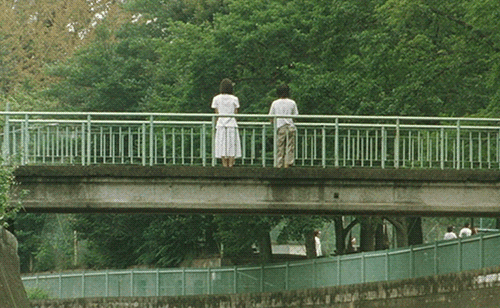
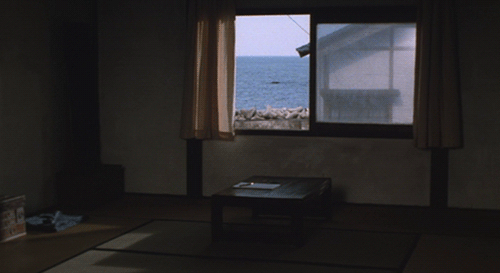




















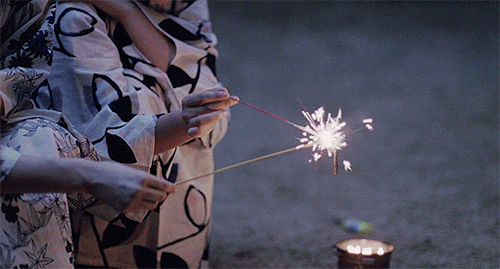
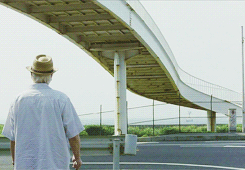

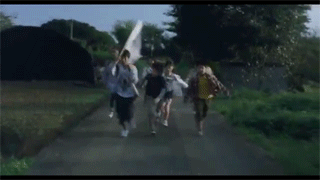



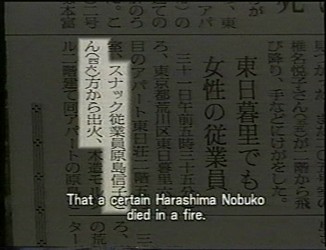







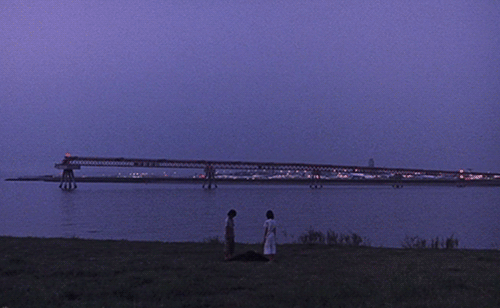

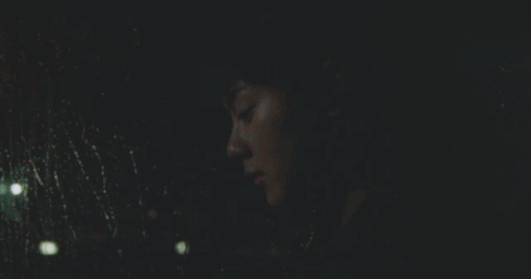




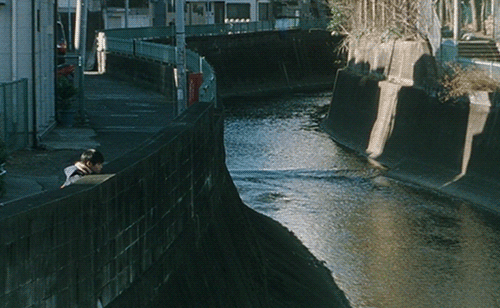





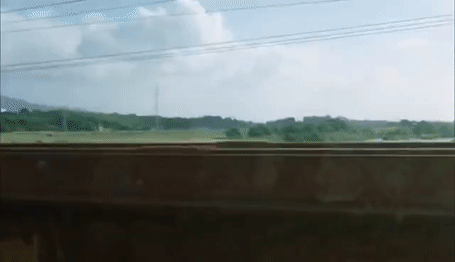










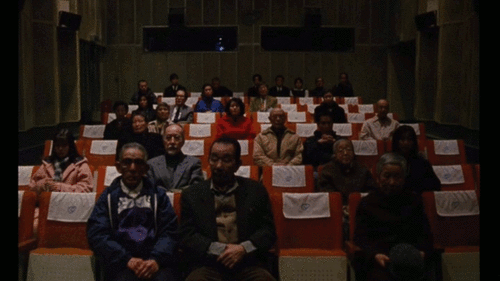











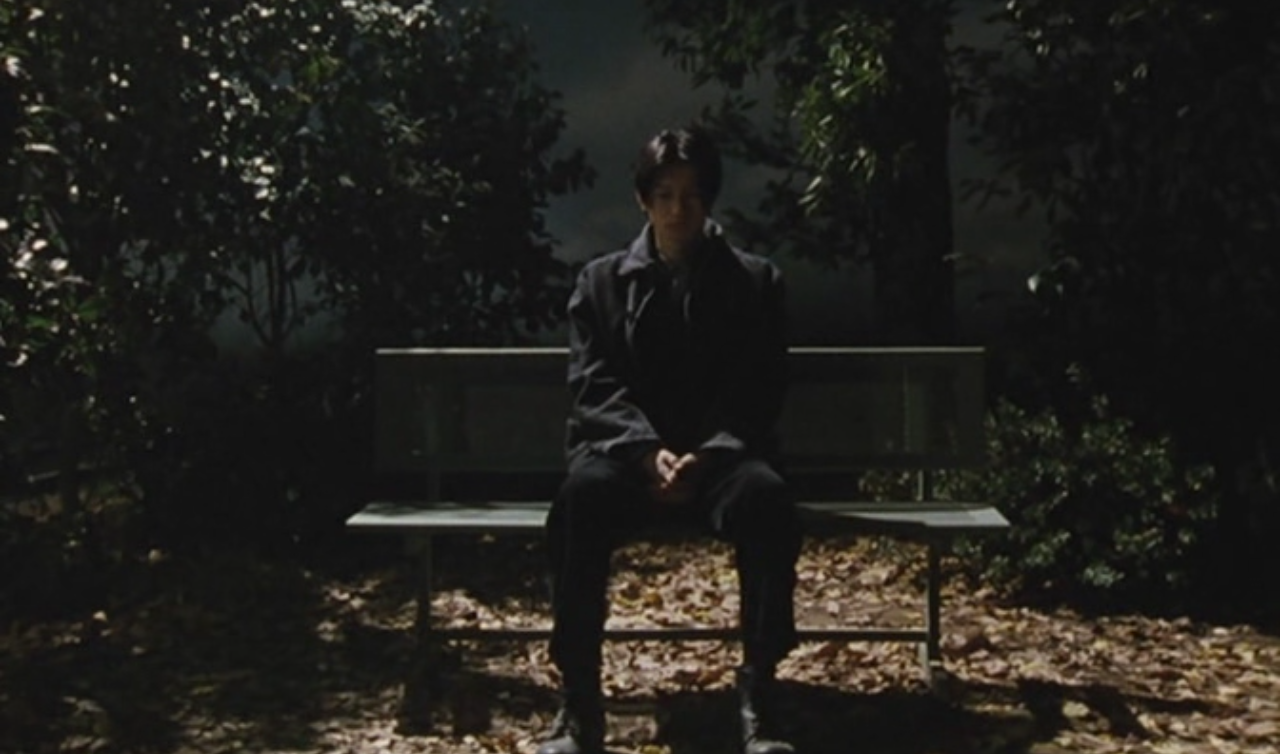
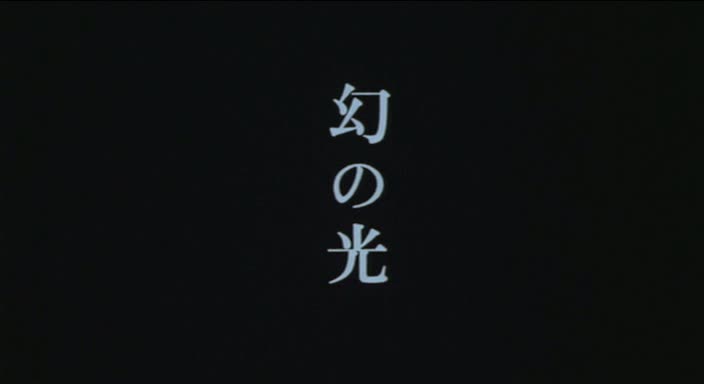
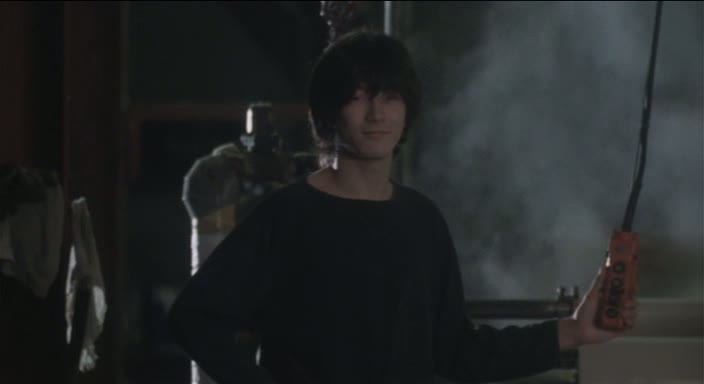

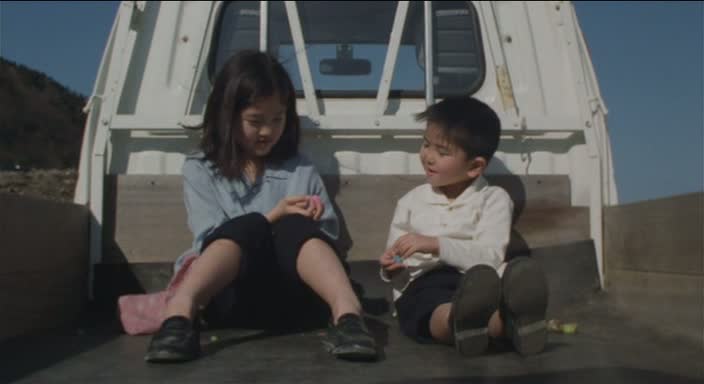


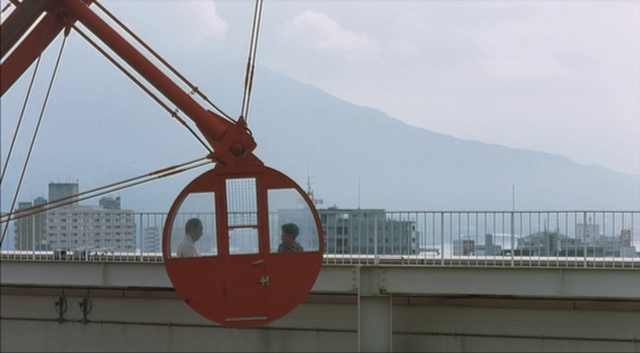
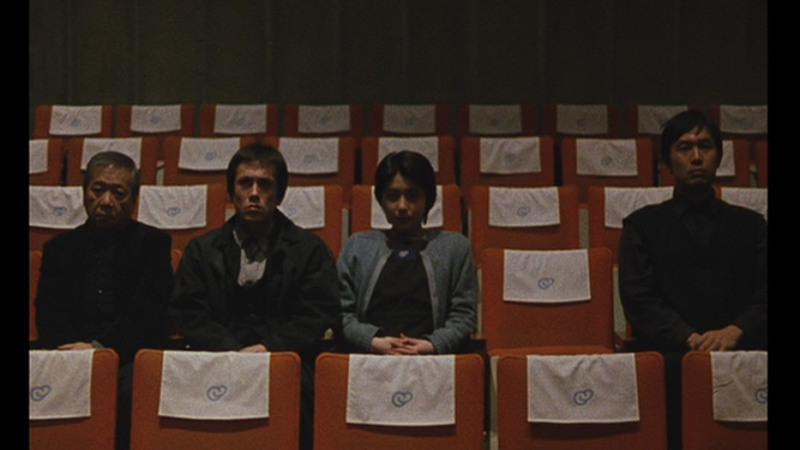
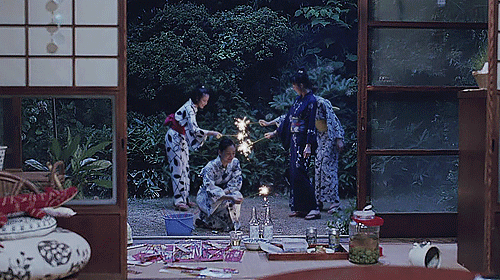
____
Further
Hirokazu Kore-eda @ IMDb
‘Hirokazu Koreeda’s Top 10 Films You Should See’
‘They compare me to Ozu. But I’m more like Ken Loach’
Hirokazu Kore-eda @ The Criterion Collection
‘Outtakes: Hirokazu Koreeda’
Hirokazu Kore-eda @ MUBI
‘The Humanists: Hirokazu Koreeda’s Maborosi’
‘Hirokazu Koreeda: One of the Best’
‘Hirokazu Koreeda: A Neorealist Approach to Filmmaking’
‘Three Sisters with Laden Hearts: Hirokazu Koreeda and the Non-traditional Family’
‘The Japanese family through Ozu’s and Korea’s cinema’
Hirokazu Kore-Eda interviewed @ The AV Club
‘A Film Guide: The Works of Hirokazu Koreeda’
‘Koreeda’s Nobody Knows: The Structure of a Fictional Documentary’
‘Hirokazu Koreeda On Bad Dads and Subtle Moments’
‘A guide to Japan’s greatest living filmmaker’
‘The evolution of visionary Hirokazu Korea’
___
Extras
The World According to Korea Hirokazu
Q&A; with the LIKE FATHER, LIKE SON Director/Writer Hirokazu Korea
Tribute to Hirokazu Koreeda
Hirokazu Koreeda – After Life – Q&A; – 2011
______
Interview
from The Rumpus
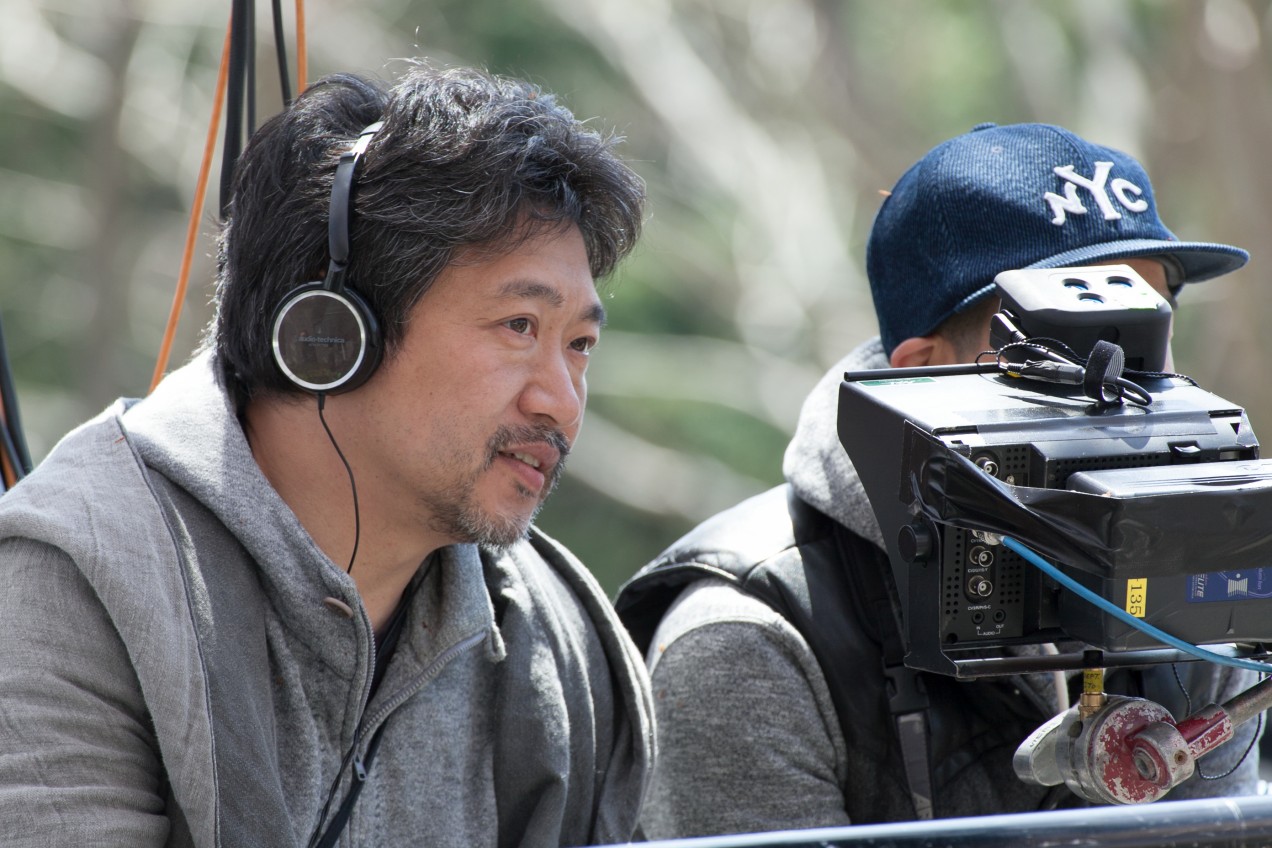
The Rumpus: You studied at Waseda University in Tokyo — famous for its literature department — in order to become a novelist. How did you end up becoming a filmmaker?
Hirokazu Koreeda: I did want to become a novelist, but the program at Waseda was pretty intense in terms of language requirements — two hours of English and four hours of Chinese. I thought, what do I need this for? So I stopped going to class. In the neighborhood around Waseda, there were all these movie theaters, so every morning I left the house and watched movies instead of going to class. The experience of encountering films then is one of my greatest memories. Before that I’d never paid any attention to directors, but there I was taking a crash course in Ozu, Kurosawa, Naruse, Truffaut, Renoir, Fellini. Because I’ve always been naturally a more introspective person, I was more interested in becoming a screenwriter than a director.
Rumpus: But then you made documentaries before you made feature films.
Koreeda: First I wrote the screenplay for Nobody Knows and showed it to people at the studios without luck. But around that time I was making a documentary about an official in the ministry of the environment who committed suicide. This man oversaw cases surrounding the victims of Minamata disease, which was a huge controversy at the time — a corporation had been found illegally dumping mercury into a river, causing thousands of deaths, horrifying disfigurement, blindness, paralysis, for which they denied culpability. This man was a morally upright person, and he was in a bind. The government didn’t want to pay out any money or admit that there was a problem, but the victims he met were clearly suffering terribly, and he sympathized with them. He was caught in the middle and ended up committing suicide.
I interviewed his wife for a television documentary and afterward wrote a book of nonfiction about it. I was deeply moved by her reaction to her husband’s suicide — how she was able to make sense of it and how and if she would be able to get on with her life. I worked on this book for two years. A producer who read it told me about a novel, Maborosi, by the writer Teru Miyamoto, that had a similar theme, and suggested I direct an adaptation of it. I’d actually read the novel as a student, but then when I looked at it again it really struck me — the core of the story was the same, about a woman trying to grapple with her husband’s suicide. I mulled over this project for five years and then finally filmed it. So my first feature took this long path from documentary to nonfiction to screen adaptation of a fictional work.
Rumpus: Your newest film, Still Walking, has more personal origins than your other films. How did this affect the making of it?
Koreeda: It’s not totally autobiographical, but I based the characters on people close to me, and a lot of the dialogue actually came from things said in my family. But whereas the challenge of, say, Nobody Knows was to take events from a real incident and then try to try to get as close as possible to the characters so I could understand them, in Still Walking it was quite the opposite: in order to avoid sentimentality and to be able to write the screenplay with the kind of humor and irony necessary to keep the story moving, I needed to distance myself as much as I could from the characters, to try to get to a point where I could view them objectively.
Rumpus: Maborosi drew comparisons to the films of Yasujiro Ozu when it came out. Still Walking seems reminiscent of Ozu’s work as well — perhaps more so.
Koreeda: When I made Maborosi, I was aware of drawing from Ozu’s style in framing certain scenes — unsuccessfully, to be honest. But Still Walking was so personal that I really set aside any consideration of technique or style or influence and just worked intuitively. The motif of family in Still Walking is similar to Maborosi, so perhaps that’s where the Ozu comparison comes from. Actually, seeing the movie now in completed form, I’d say it has more in common with Naruse’s work than with Ozu’s.
Rumpus: What about camera angles? You stick mostly to medium shots, with a minimum of close-ups, and the framing of them is similar to Ozu’s famed “tatami-eyed view.”
Koreeda: The biggest considerations I had were practical: how do you move such a large number of actors around a small space? So, for example, if I have to have the mother bring a pot of tea from the kitchen to the living room and serve it to the others, how do I, on a practical level, get everyone into the frame? Any decisions I made about the camera angles or movement came out of necessity, versus any sort of stylistic choice.
Rumpus: You’re able to get some of the most natural acting from children I’ve ever seen. Was there any particular method to this?
Koreeda: Well, the movie is pretty tightly scripted. But with the actors playing the children, I didn’t give them a script. All I told them was that this was a movie about going to their grandparents’ house during summer vacation, and that they should just run around and do whatever came naturally. The adult actors had to act around this; they had to deliver some very specific lines without knowing what the children around them would do or say. This collision of a predetermined and more random elements is something I’ve always been drawn to, and that I was pretty satisfied with in the final result.
Rumpus: Has the foreign reaction to your films ever taken you by surprise?
Koreeda: Yes. For one, I never thought Still Walking would be of any interest to Westerners or picked up overseas.
Rumpus: Why?
Koreeda: I didn’t think Westerners would get it at all. I figured, for example, that they would sit and think, why don’t these people ever just say what they’re thinking? And then the characters themselves don’t experience much growth, if any, from beginning to end.
I don’t believe in making movies to cater to a foreign audience. You never know what the reaction is going to be anyhow. At the time I made Maborosi, the Japanese movies getting any foreign attention were all period dramas and seemed to be about some representative element of Japanese life, and my movie was contemporary movie about one specific woman trying to understand her husband’s suicide. But then foreign critics right away made sweeping comparisons to haiku, noh theater, and directors like Ozu, as if the movie were somehow representative of Japan — which was, well, not what I was after. Similarly, with After Life, I deliberately set out to make a movie that was unlike what I imagined the foreign conception of Japan to be, and I figured non-Japanese wouldn’t find it interesting at all. But then again to my surprise it was also well received. Perhaps there was a stylistic element they were responding to — I was aware of Frank Capra and Ernst Lubitsch, that forties documentary style, while I was making it — so maybe that was it. At any rate, I don’t concern myself with what the critics will say; you really have no idea anyway. That’s part of the fun of making movies, seeing what the reaction will be.
Rumpus: To what extent is a film’s reception in Japan dependent on its reception overseas?
Koreeda: If a movie is nominated for, say, an Academy award, that movie will instantly become popular in Japan. There’s always been a bit of a complex the Japanese have about being taken seriously in the West. At the same time, the contemporary Japanese directors who are well-known in the West — say, Kiyoshi Kurosawa, Takeshi Kitano, Naomi Kawase — are mostly unknown to Japanese, particularly of the younger generation. One of the more problematic aspects of the current state of cinema in Japan is that the movies playing in the theaters are by and large made not by film studios but by broadcasting companies. They’re either extensions of popular television dramas or adaptations of manga or anime. Younger Japanese are simply not being exposed to good films. That situation needs to change.
Rumpus: To go back to our first question, do you ever think about writing novels? What about doing more documentaries?
Koreeda: Actually, after Still Walking was made, I was asked to write a novel version. I accepted eagerly, but then about a month into it I realized how difficult writing a novel can be. I finished it and it was published, but it was difficult. As far as documentaries go, I believe unreservedly that they serve an important function in our culture. I’d love to be able to make both documentaries and feature films simultaneously, but so far that hasn’t happened.
______________
14 of Hirokazu Kore-eda’s 22 films
_____________
August Without Him (1994)
‘Hirata Yukata became the first man in Japan to publicly acknowledge that he had contracted HIV through homosexual sex. Koreeda’s film is designed as a lament for Yukata, who had a profound impact on the filmmaker. His dying years are not presented as a time of physical deterioration, but rather an evolution of a relationship between two men, one of whom emerged from the process with a markedly changed perspective on the goal of objectivity in nonfiction film.’ — Harvard Film Archive
the entire film
____________
Maborosi (1995)
‘This is the first film by Hirokazu Koreeda, a young Japanese director whose love for the work of the great Yasujiro Ozu (1903-63) is evident. Ozu is one of the four or five greatest directors of all time, and some of his visual touches are visible here. The camera, for example, is often placed at the eye level of someone kneeling on a tatami mat. Shots begin or end on empty rooms. Characters speak while seated side by side, not looking at one another. There are many long shots and few closeups; the camera does not move, but regards. In more obvious homage, Koreeda uses a technique that Ozu himself borrowed from Japanese poetry: the “pillow shot,” inspired by “pillow words,” which are words that do not lead out of or into the rest of the poem but provide a resting place — a pause or punctuation. Koreeda frequently cuts away from the action to simply look for a moment at something: a street, a doorway, a shop front, a view. And there are two small touches in which the young director subtly acknowledges the master: a characteristic teakettle in the foreground of a shot, and a scene in which the engine of a canal boat makes a sound so uncannily similar to the boat at the beginning of Ozu’s Floating Weeds (1959) that it might have been lifted from the soundtrack.’ — Roger Ebert
Excerpt
Excerpt
_____________
Without Memory (1996)
‘A father loses his short-term memory as the result of a botched medical procedure which causes him to develop Wernicke’s Encephalopathy. Koreeda chronicles his family’s fight to receive proper treatment and benefits from this devastating malpractice. Without Memory is an unabashed protest against the government and its disregard for health care. However, the film is also rich with thematic concerns, namely memory and loss, which infuse his later fiction films.’ — Harvard Film Archive
the entire film
______________
After Life (1998)
‘Limbo becomes a place of psychological breakthrough in After Life, the film that introduced Koreeda to art-house audiences worldwide. As people die and journey to this other world, they are stopped at a sort of postmodern rest area, where they are greeted by counselors. The counselors ask the deceased to select one memory from life to take with them to the great beyond. Memories, which range from moments of first love to a trip to Disneyland, are recreated by the counselors and filmed so the departed may have a permanent record of their former lives. Despite his focus on the supernatural, Koreeda reveals a humanist sentiment on par with his fellow countryman, Yasujiro Ozu.’ — Harvard Film Archive
Trailer
Excerpt
_____________
Distance (2001)
‘Distance, nominated for the Golden Palm award at the 2001 Cannes Film Festival, focuses on the aftermath of a massacre by an apocalyptic religious cult. On the 3rd anniversary of the tragedy, four friends convene at a lake where the ashes of their loved ones are scattered. It is here where they encounter the sole survivor of the cult, who absconded just before the massacre. He gives them a tour round the religious sect’s headquarters and the characters are forced to confront their overwhelming feeling of loss as well as shame. Distance is interspersed with recollections, flashbacks and long, unbroken shots instilling a meditative tone to the proceedings. Ultimately, the film poses the question: can the characters put a distance between themselves and their loved one’s incomprehensible act of violence?’ — The Culture Trip
the entire film (w/o subtitles)
______________
Nobody Knows (2004)
‘Like his previous film Distance (2001), which involved an Aum-like cult, Hirokazu Koreeda’s Nobody Knows was inspired by a real case of child abandonment in Tokyo, 1988. As with Distance, the headline event being referenced serves as purely the catalyst for a much more personal tale. With Nobody Knows, Kore-eda took the real case, mulled it over in his head for fifteen years and used it as only the skeleton around which he built this piece of fiction, filmed with a documentary eye. The plot is simple: scatty single mum Keiko (television talento You) and 12-year-old son Akira (Yagira in the performance that made him the youngest ever Best Actor winner at Cannes) move into a nice new apartment in Tokyo. What the landlord doesn’t know is that Keiko has three other children hidden in her flat, reserved Kyoko (Kitaura), rambunctious Shigeru (Kimura) and the youngest sister, Yuki (Shimizu). When Keiko takes off with a new boyfriend, Akira is left with the responsibility of managing the household and looking after his younger siblings. The documentary style that Koreeda is known for is more prominent here than in After Life (1998), and more successful than in Distance. While the camera is often static, it doesn’t come across so much like a business training video as Distance sometimes could. However much that aesthetic may have suited the subject of that film, the camera work in Nobody Knows is easier to appreciate, catching beautiful moments of realism – childish realism, rather than stark or flat realism. One of Koreeda’s great successes is to put the audience on a level with the children, not by hackneyed devices such as dropping the camera to kid height, but through focusing on their interests, habits and practices. Several shots in the film focus on their hands touching things, the kids fidgeting. For instance, Akira’s dirty hands feeling the grooves on the suitcase, right at the start of the picture. The children of Nobody Knows are depicted as tactile beings who learn and explore through touch, taste, smell. The only words to come out of their mouths are exactly what they are feeling. The director has managed one of those rare feats, putting actual children on screen.’ — Midnight Eye
Trailer
Hirokazu Koreeda 是枝裕和 – Nobody Knows 誰も知らない – Q&A – 2011
_______________
Hana Yori Mo Naho (2006)
‘Set in 1702, Hana yori mo naho looks back a full three centuries to a time when samurai clans offered monetary rewards to the samurais who succeeded in taking on a revenge act. The central character is a young samurai, Sozaemon Aoki, who has come to Edo (now Tokyo) to avenge his late father. Although he searches the city for his father’s enemy, he is hopeless with swordplay and reluctant to pursue his mission. Living in an Edo tenement, poverty-stricken but rich in human relationships, Sozaemon starts to cherish life and question the meaning of taking revenge.’ — Film Affinity
Trailer
_______________
Still Walking (2008)
‘The lyrical, profoundly moving Still Walking (Aruitemo aruitemo) is contemporary Japanese master Hirokazu Kore-eda’s most personal work to date. Created as a tribute to his late mother, the film depicts one day in the life of the Yokoyamas, gathered together for a commemorative ritual whose nature only gradually becomes clear. Rather than focus on big dramatic moments, Kore-eda relies on simple gestures and domestic routines (especially cooking) to evoke a family’s entire life, its deep regrets and its daily joys. Featuring vivid, heartrending performances and a gentle naturalism that harks back to the director’s earlier, documentary work, Still Walking is an extraordinary portrayal of the ties that bind us.’ — The Criterion Collection
Trailer
_______________
Air Doll (2009)
‘Koreeda’s latest effort Air Doll is both his most commercial film and one of his most accomplished. Beginning life as a work-for-hire adapted from a short manga by Yoshiie Gouda, Air Doll is the story of an inflatable sex doll that gains life and goes in search of what it means to be human. Straying from the cramped, rickety house of her owner, lonely mama’s boy Hideo (Itao), the doll goes out on daily treks around the neighbourhood, befriending a variety of individuals, taking a job at a video store and even starting a relationship with her mild-mannered co-worker (Arata). Though the most immediate reference for Air Doll’s search for the true meaning of humanity would be Pinocchio, the central theme is one recurrent in Japanese literature, Frankensteinian though it may be. Ian Buruma devoted an entire chapter of his best-known collection of essays, A Japanese Mirror (a.k.a. Behind the Mask), to “The Human Work of Art”, in which he makes ample reference to the work of literary great Junichiro Tanizaki. Tanizaki’s first published work The Tattooist (Shisei, 1910) deals with the transformation of an innocent maiden into a man-eating femme fatale through the manipulation of her body – in this case a tattoo of a spider that covers her entire back. Air Doll more closely resembles another such story of Tanizaki’s, the novel Naomi (Chijin no Ai, 1924), in which a shy, unmarried engineer’s attempts to groom a teenage girl into an ideal Western-style lady see her transforming instead into a loosely moraled, manipulative wench with a string of boyfriends.’ — Midnight Eye
Trailer
Excerpt
______________
I Wish (2011)
‘Hirokazu Koreeda’s I Wish has taken two years to come to the UK. It has been more than worth the wait. Like his earlier movie Still Walking, this is a deeply considered Japanese family drama in the tradition of Ozu, with echoes of Edward Yang and Tsai Ming-liang – moving, sometimes heartbreakingly sad, often mysterious. The film is about the powerful imperative of family unity, but also about the inevitability, and even desirability, of families finally disintegrating and allowing everyone involved a painful kind of freedom. The original title is Kiseki, or “Miracle”, and a miracle is being longed for by two brothers, around nine or 10 years old: they are Koichi and Ryu, played by real-life brothers Koki and Ohshirô Maeda, from whom the director gets terrifically natural and relaxed performances. Their mum and dad have broken up; Nozomi (Nene Ohtsuka) has returned to live with her parents and taken a demeaning supermarket job in her hometown of Kagoshima, within sight of the Sakura-jima volcano, which, with eerie calm, like a figure in a painting, is in a state of silent eruption on the distant skyline. It deposits a fine film of ash over everything, which the city-dwellers must continually clean away. Koreeda does not belabour the metaphorical quality of this volcano, or the Pompei-snapshot of ordinariness he himself records. Meanwhile the father, Kenji, (Jô Odagiri) stays in Osaka, where he pursues the laid-back slacker lifestyle that so infuriated Nozomi, failing to hold down day jobs while in the evenings trying to be a guitarist in a band.’ — The Guardian
Trailer
______________
Like Father, Like Son (2013)
‘Kore-eda’s latest film, Like Father, Like Son, concerns a switched-at-birth scenario wherein two couples, the upright Ryota and Midori Nonoyima (Masaharu Fukuyama and Machiko Ono) and the laid-back Yudai and Yukari Saiki (Lily Franky and Yoko Maki), discover they’ve been raising each other’s six-year-old sons, the reserved Keita (Keita Ninomiya) and the aloof Ryusei (Hwang Sho-gen). Nature versus nurture is explored through tender melodrama, and, true to form, Kore-eda presents a wellspring of eye-catching frames and locales, each of them inviting their own thematic readings.’ — Filmmaker Magazine
Trailer
Excerpt
_____________
Our Little Sister (2015)
‘Koreeda’s sensitive yet lucid helming keeps the performances precise yet natural, and the presence of character actors in supporting roles — like Kirin Kiki, Lily Franky, Jun Fubuki and Shinobu Otake — adds flavor to the cast, even if they aren’t given much centrality in the story. Although they’re excellent actors in their own right, Shinichi Tsutsumi, Ryo Kase and Takashi Ikeda are short-changed as the Koda sisters’ love interests, to minimal emotional effect. The four distaff leads hold the screen by dint of their sheer beauty, but theirs are not career-breakthrough performances. Still, Ayase, who exudes a vivacious personality in most of the films she’s starred in, successfully conveys Sachi’s tightly wound mental state with her imposing posture and strong sense of self-discipline. This makes it hard for viewers to get under her skin most of the time, but she is radiant in scenes with Hirose’s Suzu, revealing another side of empathy and gentleness to the person she sees as her younger mirror image. Craft contributions, as expected of a Kore-eda film, is superb in an entirely unostentatious way. Especially worth noting is Yoko Kanno’s music, whose dulcet melodies and classical edge has a softening effect on the helmer’s usually austere tone. Lenser Mikiya Takimoto (“Like Father, Like Son”) captures the genteel charm of Kamakura while filtering out its more touristy spots; his pristine visuals, enhanced by an elegant color palette of blue, gray and olive, has none of the artificial glossiness suggested by his long career in commercials. However, some of the framing, notably the sisters’ upright poses and profile shots, strain to reference Ozu’s compositions. Kore-eda’s professed homage to the master of family drama (a longtime Kamakura resident) feels a little superficial compared with Still Walking which captures Ozu’s spirit rather than rigidly adhering to his technique.’ — Variety
Trailer
Excerpt
______________
After the Storm (2016)
‘Hirokazu Kore-eda first established himself as a major filmmaker with a string of audacious dramas that included a harrowing portrait of modern poverty (“Nobody Knows”) and a transcendent vision of the great beyond (“After Life”). In recent years, however — at least since 2009’s “Air Doll,” a contemporary fairy tale in which Bae Doo-na plays an inflatable sex doll who comes to life — the great Japanese humanist has downshifted towards more openly sentimental slice-of-life stories, churning out low-key masterpieces with such regularity and deceptive effortlessness that it can be easy to take them for granted. So when Kore-eda unloads another gently brilliant film full of characters so real and full of life that it feels as though could fly to Japan and visit them, it may not seem like much cause for celebration. But when one of those films is just the tiniest bit above his batting average, it’s enough to clarify and crystallize what makes them all so special. Hirokazu Kore-eda may only make good movies, but “After the Storm” is one of his best.’ — David Ehrlich, Indiewire
Trailer
_______________
The Third Murder (2017)
‘“The Third Murder” poses a battery of intriguing rhetorical questions, which the characters often ask aloud and allow to hang in the air for a half-second too long. Why does the law consider it worse if you kill for money than if you kill for revenge? Is ignoring a crime a crime unto itself? Is it at all relevant that Misumi killed two people in Hokkaido in 1986 (this is the third murder, after all), or did Kore-eda just want an excuse to interject a lyrical, snowbound interlude into a musty murder mystery? It would be against Kore-eda’s nature to answer any of these questions — a certain degree of moral ambiguity is fundamental to the warmth of his work — but he’s never made anything so cold. That’s not a problem in and of itself, but it becomes one because the filmmaker is uncharacteristically incurious about parsing the story’s major themes. As the movie stumbles from the certainty with which it started and leads Shigemori toward a very literal crossroads, it grows more frustrating (and more ironic) that this should be the first Kore-eda feature not to thoroughly investigate itself.’ — David Ehrlich, Indiewire
Trailer
AFTER THE STORM – Sujet – EV – Cannes 2016
*
p.s. Hey. ** David Ehrenstein, Hi. Yes, yes, RIP Anne Wiazemsky. So great in the Bresson and really in everything. Wait, what is that a book of Bill’s? Is he ‘David Arlen’ or is he the publisher or … what? I don’t see his name, is what I mean. It sounds very interesting. I’ll get it. ** Dóra Grőber, Hi! The meet and greet was, you know, awkward, ha ha. He’s here to watch the 12 French film submissions, including our film, and the event was set up so any filmmakers with submitted films who are in Paris could say hi. So it was basically him standing there and getting continually cornered by filmmakers giving him a hard sell on their films. Zac and I are completely incapable of that kind of behavior, so our producer, who was there, basically talked up our film while we smiled and tried to seem like pleasant guys. He seemed nice. He’ll decide which if any of the French films are worth sending to the next level whereupon the full selection committee will watch the films and decide. Apparently we will get word as soon as Monday whether we’re in the running or an immediate no. Fingers very crossed. Oh, how great that the apartment might be a go! Shoot, about all the dog walks that would be ahead of you, but it sounds good otherwise. When will you know if you get it? I hope your sickness was a phantom or an extreme quickie. How are you feeling today? My day was that meeting and the other meeting with the producer of this other big project the I should be able to identify in a couple of weeks, I think. It was okay. Productive day, I guess. Did you feel good enough to have a good enough day today? ** Steve Erickson, Hi. Great, fantastic, about putting the Day together! There’s time. Thank you a lot. What you’re thinking and planning sounds fascinating. That’s very exciting! I did not know about that Danny Brown video. How strange. I don’t … think I heard the Gravediggaz back then, but I’ll need to rehear it to make sure. That review you shared is just moronic and embarrassingly lame. ** Bill, Hi, B. I’m curious about Stephen’s new book. Fiction Collective put it out, and they generally publish very good books. And Johnny Ray Huston, wow. I haven’t seen or heard about him since the Queer Zine days. He has a book? ** Sypha, Hi, James. Ha ha, okay, 700 pages, I think it’s virtually assured that I’m not going to even attempt to read a cycle whose single books sport page numbers like that. It does sound very interesting, however. Huh. Thanks, pal. ** Matthew Doyle, Hi, Matthew! Yeah, I never check the comments on past days. I should, but I never think to. Cool, thanks for your understanding. Maybe another time? Then I’ll see you at the conference. Um, if I go to LA, and it looks like I will, I’m still not sure how long I’ll be there, hopefully for a bit. I have these things going on over here that want me to be here, and I’m trying to evade them. Was ‘Dark Harbour’ good? I always liked it ‘cos it had this sort of trashy feel relative to Knotts Scary Farm, which is kind of the god re: the big production spooky house circuit in my option, or the high budget Universal one. If/when I go to LA, it will be largely to go to haunted houses, so sure. Mostly home haunts, or they’re the priority. So, yeah, def. Wow: the helicopter filming! What’s your job? Excuse me if you told me and I’m spacing. Like … the camera guy on films or the DP or … ? I still haven’t seen ‘Good Time’. I’ve been intending to for weeks. Yeah, I’m super curious about it. A guy/film critic at the Sundance meet and greet thing yesterday was raving about it. Interesting about the ‘mini Gyro’ inventor guy. All of that is so cool. Good morning! ** Jamie, Hi, Jamie! Oh, fuck, you were sick again? That shit is taking way, way advantage of your good nature. So sorry, man, hugs. I’m good. Yep, ‘PGL’ is ‘in the can’! I mean, we have one more day of technical shit to do, outputting the various versions of the film (theater version, online version — which we had to make because two scenes in the film are so dark that, to be visible on computers, they had to be lightened a little — and the dreaded short version) and boring blah blah, but it’s finis(!), and it has now been viewed by the very first non-Zac/me human being, a programmer for Sundance Film Festival. Birth by fire. Well, I’m vegetarian since I was 16, and I eat nothing but non-meat staples, but the ‘fake meat’ thing is just a tag to make them seem comfortable or something. Like a veggie burger is just burger-like because it’s a convenient form to eat. I do eat veggie-dogs. I guess those look like meat. Dialogue-free sounds cool. For our next film, we’re going to try to bring the amount of dialogue way down if we can. ‘PGL’ has a lot of dialogue. Cool. How’s that working? May your Friday turn the Atlantic Ocean into a gigantic trampoline. Brilliantine love, Dennis. ** Corey Heiferman, Well, hello there, Corey! Ah, yes, very bittersweet sounding. I think you have the right idea even though I’ve never been able to adhere to it. How are you making the keep/discard selection, criteria-wise? Thanks about Sundance. It’s a very long shot, I think, but, yes, any least with him watching it projected, we’ll know the film had every chance. Bon day. ** Misanthrope, G-man. Fake everything, why not? Although I’ve never been able to wrap my head around the appeal of sex dolls. Yeah, it will be very interesting to get the teachers’ feedback. One always hopes that teachers can recognize kids’ qualities that don’t fit into the school requirements and appreciate a kid’s non-traditional specialness. You sound like a good adult, man. Shit, it happens sometimes. Nothing we overgrown teens can do it about that, I guess. ** Chris dankland, Hi, Chris! Thanks a whole lot, man. We’re very excited and hopeful. It’s funny how I’ve slipped into wanting to make films. It’s kind of the main thing I want to do now. Never would have predicted that. And, yeah, I personally think that, as happy as I am with ‘LCTG’, that ‘PGL’ is at a whole other level, but we’ll see. I’ve always had a burning, impractical desire to collect fake food, fill the walls and shelves of where I live with them, but I will never do it for realistic reasons. Cool, yeah, Richard Dawson’s awesome. When I first heard about him, I hoped he was the same Richard Dawson who used to host game shows on American TV and that he’d transitioned into being an experimental musician, but alas. You take care too! How’s everything? I keep utterly adoring your Facebook-posted works big time. ** Okay. I decided to restore and slightly expand the old, dead Hirokazu Kore-eda post because he and his work are really great. Have at it. See you tomorrow.




 Now available in North America
Now available in North America 
Hi!
I’m not at all familiar with Kore-eda’s work so thank you for this post! Especially for including entire movies, too!
Gosh, yes, I can imagine how awkward these events could be. I wouldn’t know what to do with myself, either… But it’s good to hear the judge seemed nice and it’s even better that you’ll hear back about his decision on Monday. Waiting is always a misery. It goes without saying: I keep my fingers tightly, tightly crossed!!
Thank you, I’m pretty happy about the possible apartment too – even with the multiple daily walks! We’ll talk to the real estate woman and the owner on Monday.
I’m still not in my top form today so I’m pretty useless. I’m having a Gregg Araki day, haha.
I’m really, really curious about this big mystery project! And about your day too! How was it? How’s your arm/shoulder? I hope you’re well by now!!
I’m bummed that Kore-eda’s latest film isn’t in the New York Film Festival, which took a wildly US/Eurocentric turn this year, and that his documentaries have never played New York.
I have discovered a lot of great music in the process of researching this project. I learned about a band called Demon Fuzz, who released an album in 1970. They were Afro-Caribbean musicians who met in England and formed the band there, and they sound a bit like Santana if the funk and Latin elements were preserved but Carlos Santana himself sounded like Ron Asheton. You can stream their whole album AFREEKA on YouTube, and it will be part of the day. I couldn’t include her in the day because she’s white, but I also learned about Ruth Copleland, a backup singer and songwriter for P-Funk who released two solo albums where she’s backed by Funkadelic in their heavy psych mode. Apparently, there’s a CD reissue containing both of them, and I will try to order it. I’ve found some really cool Funkadelic clips. I’ve always thought they were one of the greatest rock bands of all time, as good as the Velvet Underground or the Jimi Hendrix Experience, but listening to songs from MAGGOT BRAIN and COSMIC SLOP last night just confirmed this. I managed to complete the entire hip-hop section, and I don’t have a lot of free time today, but I’ll try to do one or two more artists. It would be awesome if I could find the entire 10-minute sequence from Skolimowski’s DEEP END using Can’s “Mother Sky” (the last song they recorded with their African-American singer Malcolm Mooney) on YouTube.
Tomorrow I’m seeing BLADE RUNNER 2049. The 166-minute running time scares me, and I’m wary of the hype, but I love the original so much I want to see this on opening weekend.
A filmmaker of considerable interest. “After Life” is the work of his I’m most familiar with.
Bill put out this new edition of “Way Down South” — a project he’s been working on for some time. Clarence Muse, whose work as an actor many are doubtless familiar with, wrote this account of Black Vaudeville which is chocked full of information you can’t find anywhere else.The original printing was only 500 copies, so you can imagine how expensive it is to buy it. Bill’s edition costs $12.95
Dennis, yeah, well, the funny thing is, the first book of the cycle is barely 200 pages long… practically a novella by Donaldson’s standards. But then book 2 is 455 pages. And book 3 is 518 pages. And book 4 is 674 pages. And the final one is 688. So they definitely start to swell! To be fair, the first book literally only has around 3 characters in it and the stakes are very low. By book 5 there are many, many characters and the fate of the human race is at stake, so there’s certainly a ripple effect.
On the total opposite end of the spectrum, I got the 5 book package from Amphetamine Sulphate yesterday. Most of those run in the 30-40 page range… I believe that best’s is the longest at 60 pages. So I know those will not take me long to get through!
Ahoy Dennis! How are you?
Ta very much for your good wishes.
Amazing that PGL is in the ‘can’. Must feel good. Total fingers crossed that you’ll get good news about Sundance on Monday. How very exciting and most likely nerve-wracking too.
The minimal dialogue animation’s had me stumped for a good while and the ones I watched for inspiration were not of a kind of humour I like. When things go silent they seem to go a little Mr Bean and that kind of thing makes me uncomfortable. I started writing them as strings of incidents and just kept expanding till it felt like a tale. The ones I’ve come up with so far are only okay, but I feel like I’m getting au fait with the language of them and I might be able to come up with better ones. Jonathan’s pleased with what I’ve done so far, so that’s good. The one thing that nobody’s mentioned or questioned yet is the wisdom of making animations that are supposedly to be sold as language learning tools with hardly any dialogue. I’m firmly just doing what I’m told atm, but surely potential buyers are going to mention this.
What’s your weekend going to consist of? We’re going to the ballet tonight and have Writing Gang on Sunday. Oh and I’m buying a new (to me), very cheap bass as mine stopped working.
May your weekend be like a perfumed pillow from a favourite lover.
Over-salted love,
Jamie
This post is not related to the above but I will read it. I came across your work today during a flight to Hawaii. Now that I landed I’m like is there a Barnes and Noble for me to pick up Frisk & Try on Oahu. Getting into Sarah Kane’s play compilations I feel this intense connection to alternative writing. Being in film school was the biggest let down for me in that it was all about being mainstream and never about the individual person’s voice. I think there’s a place where your afraid to try artistically to put yourself out there for fear of failure, etc. But I’m at a place where I have to express my own art and voice because it’s too painful not to be authentic and give myself to the process and grow from it. But I truly look forward to reading your work and becoming inspired to push myself to be better.
At this point, I’ve done some google and YouTube searches on things like “black psychedelic rock,” “psychedelic jazz” and “psychedelic hip-hop.” I have remembered long-forgotten trip-hop artists like Red Snapper and Attica Blues whom I liked a lot at the time, although that genre produced lots of painfully bad imitations of Portishead, Massive Attack & Tricky. I will look them up on YouTube and see if I can find any videos and figure out if any of the members of Red Snapper or Attica Blues were black. I have a vague memory of actually seeing Red Snapper live in the mid or late ’90s – I think they consisted of a female singer backed by a live band with real chops – and I recall Matador releasing one of their albums and me putting it on my top 10 list for that year. I am also going to see if I can find any YouTube clips of rap group Dalek’s collaboration with the reunited Faust. Googling “psychedelic hip-hop” turned up some weird stuff, like “acid rapper” Esham’s video “Psilycobin,” which is a gangsta rap track with no direct connection to tripping on mushrooms with a video full of clips lifted from Scorsese and Tarantino movies. He made another video that just consists of him and another rapper – a white guy who boasts about throwing Molotov cocktails and shooting machine guns at cops – walking around downtown Detroit. It looks like it was made for a budget of $3,000. I have also written to someone involved with the Afropunk festival to see if they can recommend any more contemporary artists I might not know about, but they said they’re very busy now and I should E-mail them back around the 18th or 19th.
But I also had a meeting today with the co-programmer on the Iranian film series we’re doing. At very long last, he has the director’s E-mail addresses and plans to E-mail him directly Monday morning! However, I designed the plan for the programs: 5 over the course of a week. The director has only made one feature-length film, so the rest of the programs are combinations of his medium-length films and shorts, and he has made about a dozen shorts I haven’t had a chance to see. We decided to give him carte blanche to put together a feature-length program of his favorite shorts from that batch. I think I have either written all the program notes or descriptions or reviews that can be edited down into program notes later. For the shorts, we might need the director to write his own program notes – he speaks and writes English, although we don’t know how well – or get someone to translate reviews from Iranian sources from Farsi into English. There’s no possibility he can travel here for the series, which both sucks mightily and is a relief financially.
Hey, man,
Rest In Peace Anne Wiazemsky. It’s so, so, so sad. I’m crushed. I just can’t believe it.
How are you today? Any specific plans for today?
By the way, you never did tell me who were the other two BRESSON models you met that time you met The Great Florence Delay… They couldn’t have been Dominique Sanda or Humbert Balsan himself, right??? Nor Antoine Monnier himself in the flesh either, RIGHT???!!!
“Uh, no, I was saying it was no doubt easier to make our film here because it’s in French and because Zac is French than it would have been to make … well, ‘LCTG’, which was in English, got no French funding at all, for instance.”
^ Yeah, so for example if the movie *IS* in French and takes place *IN* France and the writer-director isn’t French but has direct French ancestry???…
Sorry to bother you, but, did you indeed remember to tell Zac about my message by any chance?
“None of those texts change my opinion of him at all.”
^ Well, you say that as if I would ever want or try to change your opinion on anything; which trust me, it’s something that would *NEVER* even cross my mind.
Maybe those passages I quote didn’t really express/explain my problems with this individual and his works. I just think those things are horribly done, have absolutely nothing to say about *ANYTHING* at all, are utterly and absolutely empty, hollow, frivolous, stupid, simplistic, inane and just plain disgusting and clearly made by someone who has *A FUCKTON* of very, very serious issues; of which his Narcissistic Personality Disorder may not even be the worse at all. This person is just obsessed with stupid, senseless violence and sadism. Now, don’t get me wrong, I *LOVE* violent movies, literature and music, but in my opinion there’s absolutely nothing else behind that stupid, senseless violence and sadism in this individual’s work. I really think they are made by a person with the intellectual and emotional maturity of a 12 year old with very, very worrying tendencies and aimed at the same demographic. Not to mention his obsession with sexual/genital abuse/violence/torture/sadism and rape against male characters. All the way from that first movie of his which is a disgusting and imbecilic copy of KUBRICK’s magnificent ‘The Killing’ to his latest abortion, he’s relished with huge gusto, in *EVERY SINGLE ONE* of his works (I don’t know; *PERHAPS* ‘Jackie Brown’ would be the only exception), in sexual/genital abuse/violence/torture/sadism and rape against male characters. If he did a 10th of what he does to his male characters to his female characters; he simply couldn’t even get a single thing done; and anyway, he’d just *NEVER* do it anyway. He’s a feminazi, a misandrist, and an androphobe. And, well, that latest thing he’s released struck a *HUGE*, extremely painful personal chord with me and it made me literally sick to my stomach and experience an anxiety attack. So, yeah, I guess *PART* of my problem with the individual is personal…
ANYWAY, I *FINALLY* saw Serra’s ‘The Death Of Louis XIV’. What a GREAT, GREAT Film!!! Such magnificence! Such utter genius! I’m just speechless. All I can say is that I’m in love with that immense Work Of Art.
Take very good care, please,
Good day; good luck,
A.